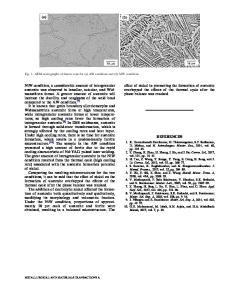Investigation on Microstructure and Impact Toughness of Different Zones in Duplex Stainless Steel Welding Joint
- PDF / 15,442,747 Bytes
- 17 Pages / 593.972 x 792 pts Page_size
- 1 Downloads / 387 Views
JMEPEG DOI: 10.1007/s11665-016-2441-5
Investigation on Microstructure and Impact Toughness of Different Zones in Duplex Stainless Steel Welding Joint Zhiqiang Zhang, Hongyang Jing, Lianyong Xu, Yongdian Han, Guolu Li, and Lei Zhao (Submitted January 22, 2016; in revised form October 31, 2016) This paper investigated on microstructure and impact toughness of different zones in duplex stainless steel welding joint. High-temperature heat-affected zone (HTHAZ) contained coarse ferrite grains and secondary precipitates such as secondary austenite, Cr2N, and sigma. Intergranular secondary austenite was prone to precipitation in low-temperature heat-affected zone (LTHAZ). Both in weld metal (WM) and in HTHAZ, the austenite consisted of different primary and secondary austenite. The ferrite grains in base metal (BM) presented typical rolling texture, while the austenite grains showed random orientation. Both in the HTHAZ and in the LTHAZ, the ferrite grains maintained same texture as the ferrite in the BM. The secondary austenite had higher Ni but lower Cr and Mo than the primary austenite. Furthermore, the WM exhibited the highest toughness because of sufficient ductile austenite and unapparent ferrite texture. The HTHAZ had the lowest toughness because of insufficient austenite formation in addition to brittle sigma and Cr2N precipitation. The LTHAZ toughness was higher than the BM due to secondary austenite precipitation. In addition, the WM fracture was dominated by the dimple, while the cleavage was main fracture mode of the HTHAZ. Both BM and LTHAZ exhibited a mixed fracture mode of the dimple and quasi-cleavage. Keywords
duplex stainless steel, fracture, microstructure, toughness, welding
1. Introduction Duplex stainless steel (DSS), with nearly equal proportion of ferrite (d) and austenite (c) phase, near-perfectly combines most of the beneficial properties of austenitic stainless steel (ASS) and ferritic stainless steel (FSS), including high strength, good toughness, and excellent corrosion resistance (Ref 1-3). Thus, DSS is increasingly being applied in various fields such as marine, power, chemical, transportation, desalination, paper, petroleum, and natural gas industries (Ref 4-7). To attain excellent properties, DSS is recommended to maintain a d/c ratio close to 1:1 (Ref 8). However, this dualphase balance in weld metal (WM) and heat-affected zone (HAZ) will be disturbed during welding process (Ref 9-11). It is well known that welding is an inevitable fabrication process in most of the applications of DSS. Gas tungsten arc welding (GTAW) is one of the most popular techniques for welding DSS because it produces high-quality welds to meet service requirements, although its low welding efficiency restricts its applications to some extent (Ref 12-14). After welding thermal
Zhiqiang Zhang, Hongyang Jing, Lianyong Xu, Yongdian Han, and Lei Zhao, School of Materials Science and Engineering, Tianjin University, Tianjin 300350, China; Tianjin Key Laboratory of Advanced Joining Technology, Tianjin 300350, China; and Gu
Data Loading...











